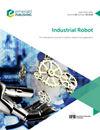Autonomous exploration through deep reinforcement learning
IF 2.5
4区 计算机科学
Q3 ENGINEERING, INDUSTRIAL
Industrial Robot-The International Journal of Robotics Research and Application
Pub Date : 2023-04-11
DOI:10.1108/ir-12-2022-0299
引用次数: 0
Abstract
Purpose Robots equipped with LiDAR sensors can continuously perform efficient actions for mapping tasks to gradually build maps. However, with the complexity and scale of the environment increasing, the computation cost is extremely steep. This study aims to propose a hybrid autonomous exploration method that makes full use of LiDAR data, shortens the computation time in the decision-making process and improves efficiency. The experiment proves that this method is feasible. Design/methodology/approach This study improves the mapping update module and proposes a full-mapping approach that fully exploits the LiDAR data. Under the same hardware configuration conditions, the scope of the mapping is expanded, and the information obtained is increased. In addition, a decision-making module based on reinforcement learning method is proposed, which can select the optimal or near-optimal perceptual action by the learned policy. The decision-making module can shorten the computation time of the decision-making process and improve the efficiency of decision-making. Findings The result shows that the hybrid autonomous exploration method offers good performance, which combines the learn-based policy with traditional frontier-based policy. Originality/value This study proposes a hybrid autonomous exploration method, which combines the learn-based policy with traditional frontier-based policy. Extensive experiment including real robots is conducted to evaluate the performance of the approach and proves that this method is feasible.通过深度强化学习进行自主探索
配备激光雷达传感器的机器人可以连续执行有效的制图任务,逐步构建地图。然而,随着环境的复杂性和规模的增加,计算成本非常高。本研究旨在提出一种混合自主探测方法,充分利用激光雷达数据,缩短决策过程中的计算时间,提高效率。实验证明了该方法的可行性。设计/方法/方法本研究改进了测绘更新模块,提出了一种充分利用激光雷达数据的全测绘方法。在相同的硬件配置条件下,扩展了映射的范围,增加了获得的信息。此外,提出了基于强化学习方法的决策模块,通过学习策略选择最优或接近最优的感知行为。决策模块可以缩短决策过程的计算时间,提高决策效率。结果表明,混合自主探索方法将基于学习的策略与传统的基于边界的策略相结合,具有良好的性能。独创性/价值本研究提出了一种混合自主探索方法,将基于学习的策略与传统的基于边界的策略相结合。通过包括真实机器人在内的大量实验来评估该方法的性能,并证明了该方法的可行性。
本文章由计算机程序翻译,如有差异,请以英文原文为准。
求助全文
约1分钟内获得全文
求助全文
来源期刊
CiteScore
4.50
自引率
16.70%
发文量
86
审稿时长
5.7 months
期刊介绍:
Industrial Robot publishes peer reviewed research articles, technology reviews and specially commissioned case studies. Each issue includes high quality content covering all aspects of robotic technology, and reflecting the most interesting and strategically important research and development activities from around the world.
The journal’s policy of not publishing work that has only been tested in simulation means that only the very best and most practical research articles are included. This ensures that the material that is published has real relevance and value for commercial manufacturing and research organizations. Industrial Robot''s coverage includes, but is not restricted to:
Automatic assembly
Flexible manufacturing
Programming optimisation
Simulation and offline programming
Service robots
Autonomous robots
Swarm intelligence
Humanoid robots
Prosthetics and exoskeletons
Machine intelligence
Military robots
Underwater and aerial robots
Cooperative robots
Flexible grippers and tactile sensing
Robot vision
Teleoperation
Mobile robots
Search and rescue robots
Robot welding
Collision avoidance
Robotic machining
Surgical robots
Call for Papers 2020
AI for Autonomous Unmanned Systems
Agricultural Robot
Brain-Computer Interfaces for Human-Robot Interaction
Cooperative Robots
Robots for Environmental Monitoring
Rehabilitation Robots
Wearable Robotics/Exoskeletons.

 求助内容:
求助内容: 应助结果提醒方式:
应助结果提醒方式:


